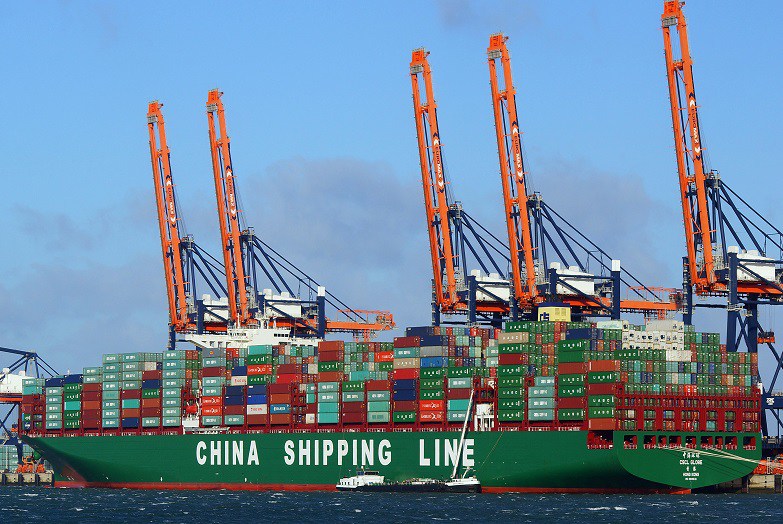Mieux comprendre les intentions des dirigeants et les tendances émergentes à l’œuvre en Chine, en s’appuyant sur des sources chinoises, c’est la finalité du dossier « China Analysis » de l’European Council on Foreign Relations (ECFR). L’article propose un tour d’horizon critique des appréciations portées par les analystes chinois sur les opportunités commerciales sur le pourtour méditerranéen, opportunités commerciales inscrites dans le cadre du projet de nouvelle route de la soie (« One Belt, One road » – OBOR ou « Belt and Road Initiative »-BRI).
——————————————————————————————————————————————-
Les opinions exprimées dans cet article n’engagent pas le CSFRS.
Les références originales de ce texte sont: François Godement, Dragan Pavlićević, Agatha Kratz, Abigaël Vasselier, Moritz Rudolf & Jérôme Doyon, « China and the Mediterranean: open for business? « , ECFR, China Analysis, 21 juin 2017.
Ce texte, ainsi que d’autres publications, peuvent être visionnés sur le site de l’ECFR.
——————————————————————————————————————————————
China and the Mediterranean: open for business?
Partnering with China on its ‘One Belt, One Road’ initiative, also known as the ‘Belt and Road Initiative’ (BRI), is often like looking at the sky from the bottom of a well (a Chinese proverb, 井底之蛙 , jingdi zhi wa, ‘the frog at the bottom of the well’). Each country is addressed in terms of the wonderful opportunity China presents, in the form of investment, lending, or an improvement to their relationship in general, in what is essentially a bilateral silo. But, just as the sky is large, the BRI in practice covers a range of countries now exceeding the original 65 in 2015. Each of them are at the bottom of their own well, looking up. It is in fact very difficult to distinguish the BRI from the general policy of zouchuqu (‘going out’) – the move abroad by China’s economy. BRI is really about spreading out across the world, except for the United States, which represents one of the BRI’s only real geographical limitations.
This issue of China Analysis, featuring Chinese think-tankers who share their views on the BRI in Europe and the MENA region, lifts us out of the proverbial well. In this edition, scholars weigh up the risks and opportunities of the BRI, mentioning very little about the grand scheme of things or the global order. Rather explicitly, the analysts ponder whether this is good business for China, and describe some of the obstacles. The list of ports China has invested in, or planned to invest in, may be one of the answers: there is great diversity, between Piraeus, the new ‘three Seas’ initiative, ventures in Italy and Spain (the articles do not mention that Slovenia turned down several Chinese projects), and a major but little heard of project on the Algerian coast.
Beyond the details of the projects is the matter of what Chinese businesses think about them. Scepticism lurks beneath the surface due to those tough European Union rules and the alleged ‘cultural’ distance (another euphemism for rules). Relentlessly, Chinese analysts cite the obstacle of labour: indeed, Chinese firms are most successful when they employ their own workers on their own terms. Not being able to do so in the EU is a major concern for them. A dilemma also appears: because it was politically easier in less developed economies, China has planned a lot of projects (not necessarily yet implemented) in central and eastern Europe. But are the local markets really large enough to justify this? Chinese businesses also cite ‘protectionism’. This phrase sometimes means that EU rules favour insiders, but also that there are local concerns about Chinese investment. Quite wisely, some of these analysts recommend a bottom-up approach – from successful cases of Chinese and local firms working together on reciprocal bases, often through joint ventures.
Fears about European geopolitics appear to be second hand and remain rather unspecified: ‘refugees’, ‘populism’, and, probably more to the point, frequent changes of governments (Italy being a prime example) matter to a China whose own approach is very much top-down. The prospect of a possible investment treaty between the EU and China – an issue unresolved after 13 rounds of negotiation – is never touched on by the scholars, as if it is a ‘no-go’ area. In the case of Italy, the analysis focuses on high-tech and brand name acquisitions in the wake of the Italian economic downturn. Analysts deny accusations of opportunism, but Chinese investors do not shy away from a good investment opportunity. The only real mention of the EU is those infernal rules…
In contrast, when it comes to the Middle East and North Africa, the focus is far more on governance and geopolitical issues, even though the region has obvious potential as a supplier of infrastructure, and even though energy purchases represent one of China’s main economic interests there. Algeria, and Morocco even more, are fairly close to EU rules and European influence. Egypt is a land of its own with bureaucracy, corruption, but no real impetus from above. In fact, while there is an interesting focus on taking forward Egypt-China cooperation, several other analysts instead prioritise the rich Gulf states. Politically, mention of China’s support for Iran is restrained, while the role of Saudi Arabia and others in curtailing extremism is prominent. One might note that China’s practical problem is Sunni, not Shia, Islam; the country would do well by coming to an understanding with the Sunni leaders of the region, including even Turkey.
In sum, the Chinese press and analysts are a useful source for exploring what concerns exist in China about the grand BRI that has captured so much attention abroad, and that represents a real success for China’s public diplomacy and soft power.
Europe is the end destination for China’s Belt and Road Initiative (BRI), so it is imperative to understand the developments that are taking its southern branch, the 21st Century Maritime Silk Road (MSR), from concept to reality. Discussion of Chinese infrastructure projects and their impact on established trade and investment patterns will likely dominate Sino-European relations in the coming years, bringing both challenges and opportunities.
Compared with the BRI’s northern, land, route, there is little clarity about how the southern, maritime, route will look. Official maps depict the ports of Piraeus in Greece and Venice in Italy as end points. However, nothing is set in stone, and Chinese interests will be formed by available opportunities rather than by what is outlined on its official map.
China’s interest in Mediterranean ports
Greece is currently a key terminus for the MSR. In 2008 a lease arrangement was signed for two terminals at the port of Piraeus. China Ocean Shipping Company (COSCO) then acquired a majority stake in the port in August 2016[1]. Over this period, the port’s capacity, infrastructure, operations, and revenues have reportedly improved significantly due to Chinese investment and management, and through an increased volume of imports from China passing through it[2]. Recently, COSCO acquired a 40 percent stake in the company which will operate two terminals in the port of Vado in Italy. It has also registered an interest in leasing a terminal at the Algeciras port in the south of Spain, but details are currently hazy[3].
Over the last five years, China’s interest in maritime infrastructure and inland ports in central and eastern Europe (CEE) has been reported only sporadically in local media, and has not yet led to any firm agreements. However, in 2015, during the China-CEE Summit in Suzhou, the Chinese premier, Li Keqiang, set out the concept of ‘Adriatic- Baltic-Black Sea Seaport Cooperation’ (also referred to as the ‘Three Seas Port Cooperation’), in which he envisioned “establishing industrial cluster areas around ports with the right conditions”[4]. He specified that the approach should combine “China’s equipment, European technology and central and eastern European markets on the way to achieving productive cooperation projects”. This idea is thus an embodiment of Li’s signature concept of “industrial capacity cooperation”[5]. The Three Seas initiative has since become an important part of the discussions taking place in the 16+1 framework.
One recent article focusing on the French city of Marseille also illustrates how China’s interest in ports in the Mediterranean extends beyond acquisitions or upgrades, as well as state-driven strategies[6]. An initiative called the Marseille International Trade City (MITC) is being established in the vicinity of the city’s port. It aims to make Marseille the largest wholesale trade centre in the Mediterranean. Initiated and financed by Chinese private enterprises, the MITC is set to house more than 200 wholesalers and to provide a trading platform for small- and medium-sized enterprises from France, Italy, eastern Europe, north Africa, and China.
Why European ports?
According to widespread media reports, Greece’s Piraeus port is a European gateway for Chinese goods and a southern bridgehead to Europe[7]. The shipping of goods to European markets via Piraeus is more time- and cost-effective than via ports in other parts of Europe. Furthermore, Chinese ownership of Piraeus will speed up the implementation of the ‘China- Europe Land-Sea Express Lane’, a plan for the modernisation of the railway link from the port of Piraeus, through the Balkans to Hungary and onwards, which will further cut transport time and “narrow the distance between China and east and south Europe”, in accordance with the “spirit” of the BRI[8].
Zhen Yin, deputy director at the Institute of Transport Planning Research Office at the National Development and Reform Commission’s Transport Research Institutes, observes that the countries of the Three Seas area play an important role in both the ‘16+1’ format and the BRI. ‘Adriatic-Baltic-Black Sea Seaport Cooperation’ therefore also has strategic value for securing three-party cooperation with the CEE and the European Union[9].
Jia Dashan, vice-president of the Water Transport Science Research Institute of the Ministry of Transport in China, discusses maritime shipping in a geopolitical context. For Jia Dashan, maritime shipping occupies a central place in both China’s traditional and non-traditional security. Jia Dashan highlights its importance for China’s access to sea lanes and maritime resources, the ability to efficiently transport people and resources, and to facilitate economic development through efficient, unimpeded trade[10].
Challenges
Chinese commentators perceive a wide range of risks and challenges related to maritime cooperation within Europe and beyond. Yin Zhen notes that the populations and economies of the Three Seas area are small, and that ports in the region have limited capacity. Drawing on the analysis of the relevant enterprises and research institutions, Yin Zhen suggests that for these ports the investment payback period is longer, and the investment risk higher. Yin Zhen therefore suggests that China’s decision about whether to commit large assets to investments in construction and operation of the Three Seas ports should be based on careful consideration and only when there is sufficient evidence that these investments make financial sense.
Yin Zhen also notes that the EU presents China with a challenge. He notes that the EU “still has doubts and fears” about China’s involvement in large-scale infrastructure projects in the area. Furthermore, Yin Zhen notes that EU competition rules and commercial policy ensure that it has “exclusive rights and advantages”, and that each EU member state must obtain authorisation by the EU or comply with EU law to move forward with potential projects. Hence, Chinese enterprises invariably face barriers to entry related to public procurement, setting up production chains, third party investments, and employment, among other things[11].
Jia Dashan is primarily concerned with the accumulated consequences of the global financial crisis, the Ukraine crisis, and the migration crisis, which have delivered “the gravest geopolitical test to Europe in more than 30 years” by causing significant economic, social, and political turbulence. He also discusses the rise of anti-globalisation and protectionist tendencies and their negative effects on China’s economy. He notes that all of these factors have resulted in a slower growth rate for sea shipping, and delivered a stark challenge to the global shipping industry, including China’s own, as well as to China’s economy at large[12].
Going forward
To overcome the challenges identified, Yin Zhen urges China to direct research, policymaking, financing, and collaboration efforts towards a holistic package where industrial parks, ports, and “supporting systems and functions” are developed in sync with the corridor approach envisioned under BRI.
Furthermore, China should encourage partnerships between its own enterprises, host countries, and the EU to cooperate on the projects related to the ports and other infrastructure networks. For this to be possible, Yin Zhen argues, Chinese enterprises should obtain the relevant EU accreditation for its technology, equipment, and engineering and technical personnel.
On a tactical level, Yin Zhen recommends linking up with the Juncker Plan, an investment programme central to the EU’s efforts to ensure stable and sustainable growth in Europe. China should also continue ‘lobbying’ efforts with European governments and strengthen communication with the EU to address its doubts. State-level involvement is necessary, according to the Chinese consul-general to Marseille, Zhu Liying, who highlights the importance of several documents signed between Marseille’s local government and Chinese enterprises in recent years. These documents dispelled some of the initial concerns on the French side and prompted Marseille to pursue Chinese investors more proactively[13].
Jia Dashan complements Yin Zhen’s thinking by recommending that China should conduct regular assessments of geopolitical and local-level risks, including along the BRI routes. Jia Dashan also advises the government to “actively shape the transnational characteristics of enterprises” through means such as “diversification” of enterprises’ operations, setting up overseas subsidiaries, globalisation of their capital, and developing joint ventures. He also urges enterprises to strengthen their corporate diplomacy, make more efforts to “integrate and embed” themselves in the host countries, and develop relations with all relevant stakeholders to improve their business prospects[14].
Conclusion
The number of European ports earmarked by China betrays the open and flexible nature of China’s BRI, despite the rigidity of its official maps. For China, fulfilling its end goal − to develop trade links and various forms of economic cooperation and integration – is much more important than the form that this takes. But China is clearly well aware of the obstacles standing in its way, and the analyses reviewed here clearly express the need for the government and private enterprises to adjust to a dramatically different European business and political context.
This suggests that European countries insisting on adherence to EU standards and pursuing one’s own interests will not damage the prospects of identifying suitable projects and attracting Chinese capital. After all, China, and Chinese enterprises, will seek to invest in and expand their operations in Europe for as long as there is a solid ‘business case’ to do so.
References
Par :
Source : European Council on Foreign Relations
Mots-clefs : Asie, Chine, Commerce, Europe, International, Maritime, Méditerranée, Mer, Ports, Transports, Union Européenne


































